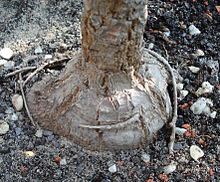Lignotuber

A lignotuber is a woody swelling of the
Plants possessing lignotubers include many species in Australia: species.
Plants possessing lignotubers on the western coast of the USA include California buckeye, coast redwood, California bay laurel (aka Oregon myrtle), and multiple species of manzanita and Ceanothus.[2]
At least 14 species in the
The fire-resistant lignotubers of Erica arborea, known as "briar root", are commonly used to make smoking pipes.
The largest known lignotubers (also called "root collar burls") are those of the Coast Redwood (
Many plants with lignotubers grow in a shrubby habit, but with multiple stems arising from the lignotuber. The term lignotuberous shrub is used to describe this habit.[citation needed]
See also
- California chaparral and woodlands
- Chaparral
- Crown sprouting
- Epicormic shoot, also fire-induced buds
- Fire ecology
- Geoxyle
- Resprouter
References
- S2CID 17448762.
- ^ ISBN 978-0-521-82491-0.
- ^ Thomson, Sophie (14 October 2006). "Mallee Trees". Gardening Australia. Series 17, Episode 35. Australian Broadcasting Corporation. Archived from the original on 11 November 2020. Retrieved 25 May 2021.
- JSTOR 2445037.
- ^ Del Tredici, Peter (Fall 1999). "Redwood Burls – Immortality Underground". Arnoldia. 59 (3): photo and caption p. 19.
- ^ Esterhuyse, Neels; et al. Remarkable Trees of South Africa. Pretoria: Briza Publications. pp. 102–103.
- ^ Pakenham, Thomas. Remarkable Trees of the World. New York: W. W. Norton and Co. pp. 122–123.
- ^ "National Register Of Big Trees". Archived from the original on 29 October 2017. Retrieved 27 October 2017.
